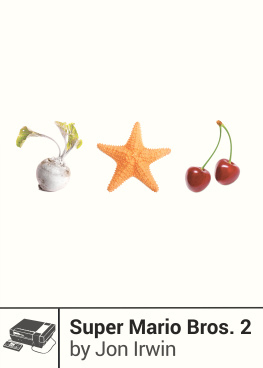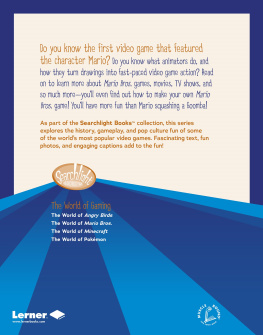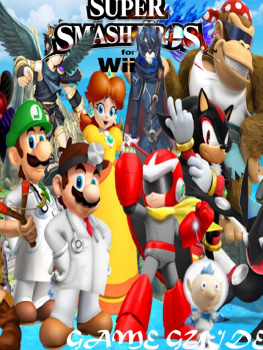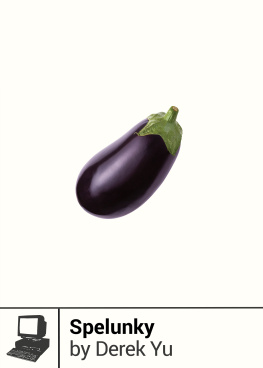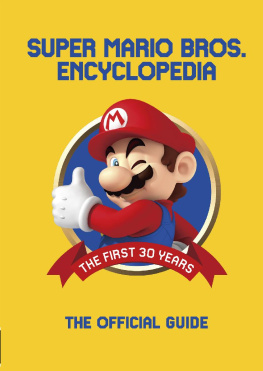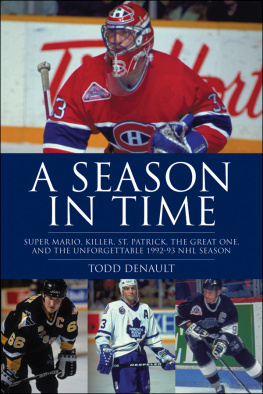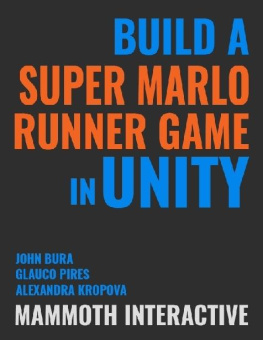Irwin Jon - Super Mario Bros. 2
Here you can read online Irwin Jon - Super Mario Bros. 2 full text of the book (entire story) in english for free. Download pdf and epub, get meaning, cover and reviews about this ebook. City: Los Angeles, year: 2014;2016, publisher: Boss Fight Books, genre: Romance novel. Description of the work, (preface) as well as reviews are available. Best literature library LitArk.com created for fans of good reading and offers a wide selection of genres:
Romance novel
Science fiction
Adventure
Detective
Science
History
Home and family
Prose
Art
Politics
Computer
Non-fiction
Religion
Business
Children
Humor
Choose a favorite category and find really read worthwhile books. Enjoy immersion in the world of imagination, feel the emotions of the characters or learn something new for yourself, make an fascinating discovery.
- Book:Super Mario Bros. 2
- Author:
- Publisher:Boss Fight Books
- Genre:
- Year:2014;2016
- City:Los Angeles
- Rating:3 / 5
- Favourites:Add to favourites
- Your mark:
- 60
- 1
- 2
- 3
- 4
- 5
Super Mario Bros. 2: summary, description and annotation
We offer to read an annotation, description, summary or preface (depends on what the author of the book "Super Mario Bros. 2" wrote himself). If you haven't found the necessary information about the book — write in the comments, we will try to find it.
Super Mario Bros. 2 — read online for free the complete book (whole text) full work
Below is the text of the book, divided by pages. System saving the place of the last page read, allows you to conveniently read the book "Super Mario Bros. 2" online for free, without having to search again every time where you left off. Put a bookmark, and you can go to the page where you finished reading at any time.
Font size:
Interval:
Bookmark:
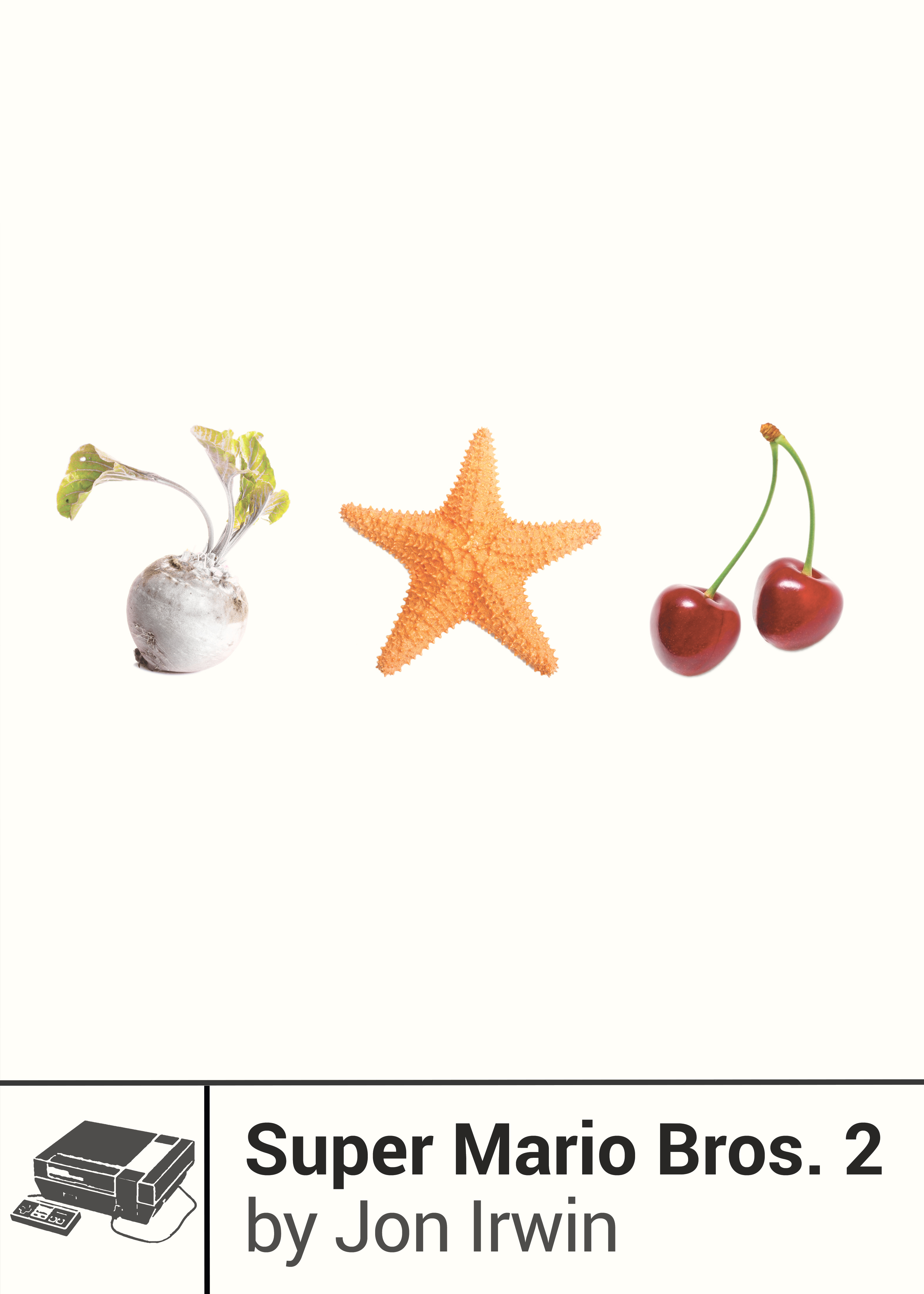
Super Mario Bros. 2
Jon Irwin
Boss Fight Books
Los Angeles, CA
bossfightbooks.com
Copyright 2014 Jon Irwin
All rights reserved.
ISBN 13: 978-1-940535-05-0
First Printing: 2014
Second Printing: 2016
Series Editor: Gabe Durham
Book Design by Ken Baumann
Page Design by Adam Robinson
For Elizabeth,
who taught me the difference
PLEASE SELECT
Video games have played a huge role in my life. As Nintendos Gamemaster, I played and analyzed every game developed by and for Nintendo prior to 1991. During that period, I developed a deep understanding of games and the rich personal experiences they provided players. I knew key staff well at Nintendo of America and, to a limited degree, Nintendo Co., Ltd. in Kyoto, Japan. I considered then-president of Nintendo of America Minoru Arakawa (Mr. A) to be my friend. The story and history Jon Irwin recounts in this book I lived firsthand.
I first met Mario as Jumpman in the arcade hit Donkey Kong while serving as warehouse and shipping manager for Nintendo of America in 1981. The Donkey Kong arcade game quickly became a phenomenal hit in the US. Initially manufactured in Japan and shipped through the Nintendo of America warehouse in Seattle, Washington, Donkey Kong was so successful that for a brief period Nintendo was the largest-volume shipper through the Port of Seattle.
By the time Shigeru Miyamotos Super Mario Bros . was released in 1985, my role as shipping and warehouse manager had expanded to include reviewing with a Western eye all new Japanese Nintendo products, arcade games, Game & Watch handheld games, and Famicom games, reporting my results to Mr. A.
In the early spring of 1985, Mr. A gave me a box of 40-some-odd Nintendo Famicom games and asked me to play each one and recommend which games should become launch titles for the Nintendo Entertainment System in the US. The story of the launch of the NES is longer than this foreword allows, but of the games in that box, it was Super Mario Bros . that made the biggest impression.
My experience with Super Mario Bros. 2 began in the summer of 1986 when I received a new box from Nintendo that contained yet another set of new titles for both the Famicom and the recently released Famicom Disc System. One of these Famicom discs was Super Mario Bros. 2 .
I was surprised that the disc had arrived at my desk without any fanfare or advance warning. After all, it was the sequel to the NESs most popular game. I quickly loaded the game and began playing. What came next was completely unexpected.
I was immediately killed by a mushroom that, unlike the mushrooms in Super Mario Bros. , was now poisonous. Chagrinned but undaunted, I continued playing only to be taken by a strong, unpredictable wind and tossed into a chasm. Soon after, I succumbed to the jaws of a red piranha plant that uncharacteristically rose from a pipe that I was already standing ona platform that in Super Mario Bros. had always been safe.
As I continued to play, I found that Super Mario Bros. 2 asked me again and again to take a leap of faith and that each of those leaps resulted in my immediate death. This was not fun gameplay, it was punishment undeserved punishment.
I put down my controller, astonished that Mr. Miyamoto had chosen to design such a painful game. It was only later that I came to understand that Mr. Miyamoto had handed off most of the design responsibility of Super Mario Bros. 2 to other Nintendo staff. Apparently, during the year prior to the Japanese release of Super Mario Bros. 2 , Mr. Miyamoto had focused most of his energies on the design of future hit The Legend of Zelda .
Amazed at how dark and punishing the supposedly entertaining Super Mario Bros. 2 was, I immediately shared my thoughts with Mr. Arakawa. In his typical stoic manner, Mr. Arakawa simply acknowledged my comments. By this time, I was well aware of the cultural differences within Nintendo that made bad news known but rarely discussed.
It may seem strange, but in the spring of 1986, Super Mario Bros . was no longer the franchise to watch to those inside Nintendo. Mr. Miyamotos The Legend of Zelda had launched in Japan on Famicom in February and was experiencing great success. Zelda is an incredibly deep and engaging game. So engaging that I managed to successfully complete it even though all the in-game hints and directions were in Japanese script Hiragana and Katakanatext that I could not read or understand. By the time Super Mario Bros. 2 crossed my desk, I had already completed The Legend of Zelda and was lobbying hard for its quick release in the US.
It wasnt until 1988 that a new version of Super Mario Bros. 2 arrived on my desk. I immediately recognized it as a remake of a Famicom game that I had reviewed the previous year. I found the new Super Mario Bros. 2 to be a lot of fun and I told Mr. A so. The rest, as they say, is history.
This book provides a great service by documenting in engaging detail a period in history that meant so much to so many of us. As I read this book, I was reminded of the wonder of playing classic video games. Players will understand and remember fondly the nuanced aspects of gameplay that Jon Irwin describes.
While many have written about the video games of the 80s, no one has previously captured with such a keen eye the pixel-level detail of a game from that era. Irwin has created a rich period piece that accurately describes what happened to Super Mario Bros. 2 and why. At the same time, he has captured the magic of what it was like to be a kid playing video games when Nintendo and Super Mario ruled the world.
Howard Phillips
Summer 2014

Playing a Mario game is about finding secrets. There may be obvious rewardsa flagpole awaiting a well-timed jump, or some floating star to nab, or the sheer joy of moving gracefully through designed spacebut the guts of a great Mario game reside elsewhere, tucked away within the scenery. To uncover that which remains hidden: This is the Mario players true goal.
Such secrets abound. Their presence tantalizes, buried under the surface, its scent seeping through pixelated bricks. Defeating the final villain is the usual climax; grabbing coins is an ever-present dripfeed of adrenaline. But go back and look more closely. Discover that hidden enclave. Unearth a fount of extra lives. Duck beneath the ground and find yourself in another world. Each moment brings with it a feelingthat ping of bright surprise or smooth warmth of elationthat makes you play and play again.
What happens then, when instead of lying behind coded architecture, a games best secret is the story of the game itself?
I screamed and ran to smash my favorite slot machine
David Bowie
He is immortal. A shape-shifter , a workaholic. Possible misanthrope. His interests are many: virology, golfing, the Olympiad. He exists on shirts, wall decals, baseball caps, backpacks, notepad doodles. Millions of strangers can hum the melody to the soundtrack of his life. Millions more control his chubby body in one of hundreds of video games bearing his likeness and name: Mario.
Im writing this at my desk in Medford, Massachusetts, a town outside of Boston where I live and work. I am 32 years old. I just celebrated my one-year wedding anniversary with a lovely girl from Pennsylvania. On my desk is a small paper calendar turned to the present month, June. There flies Mario, spreading his Squirrel Suit wings as first seen in New Super Mario Bros. U , a game released in 2012 for Nintendos latest video game home console, the Wii U. I turn my head left: On a small shelf sits a cartridge for Mario vs. Donkey Kong , a 2004 game for Nintendos handheld system Game Boy Advance. Below this is a Super Nintendo, the companys 16-bit console released in 1991, Super Mario World in the slot waiting to be powered on.
Font size:
Interval:
Bookmark:
Similar books «Super Mario Bros. 2»
Look at similar books to Super Mario Bros. 2. We have selected literature similar in name and meaning in the hope of providing readers with more options to find new, interesting, not yet read works.
Discussion, reviews of the book Super Mario Bros. 2 and just readers' own opinions. Leave your comments, write what you think about the work, its meaning or the main characters. Specify what exactly you liked and what you didn't like, and why you think so.

